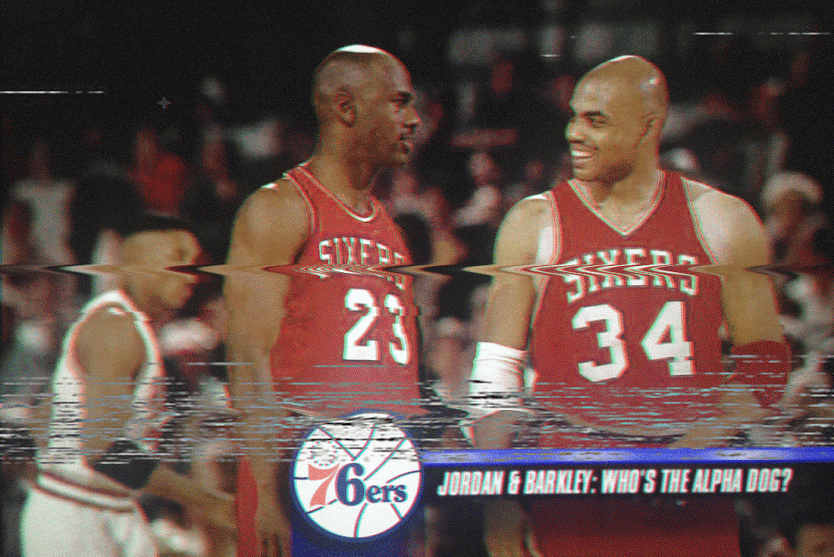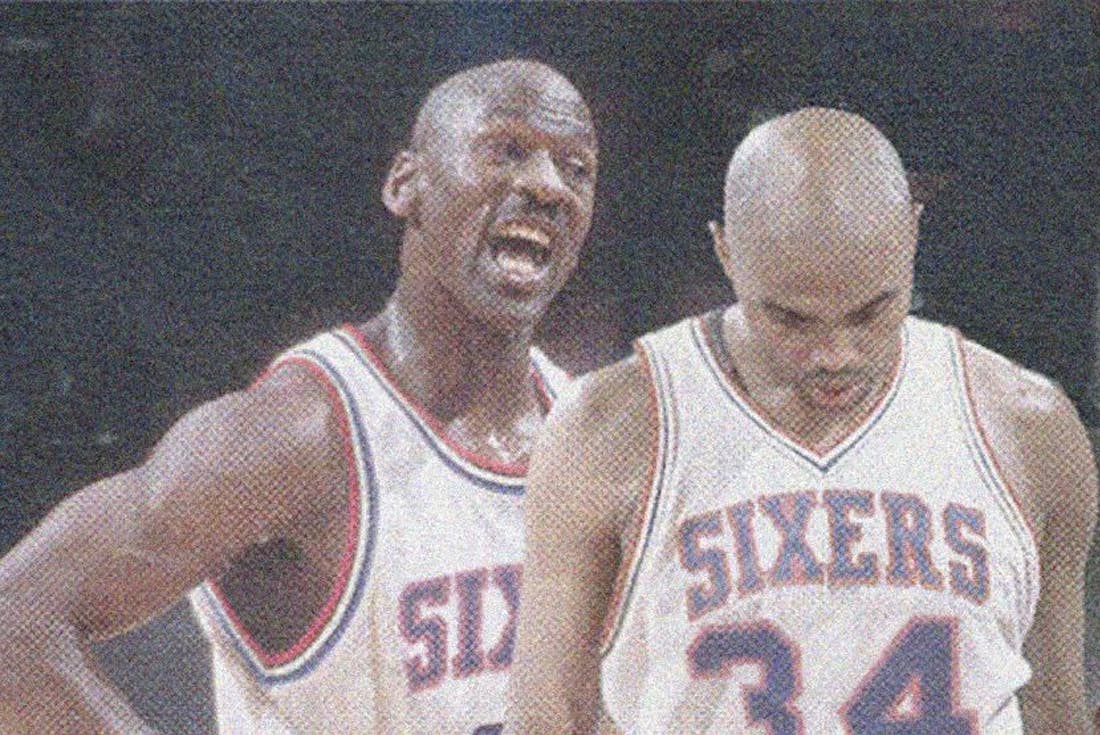
My childhood should've been lit.
It should've been filled with annual ticker tape championship parades down Broad Street, memories of basketball domination from the greatest duo in NBA history, and countless word-of-mouth stories from friends and family of run-ins with the greatest roundball player to ever grace planet earth.
That's how it should've been. It wasn't. Michael Jordan never played for the Philadelphia 76ers, he never partnered with Charles Barkley to form an NBA tandem for the ages, and nan one of my people have any exciting "then MJ bought out the bar" tales of revelry and debauchery. Why? Because of one man—Rod Thorn.
From NBA TV's documentary, The 84 Draft:
"Rod Thorn the General Manager he got an offer [for the third pick] from the Philadelphia 76ers for Julius Erving." —Filip Bondy, author, "Tip Off" (1984 Draft)
"We were offered several enticing deals, but in our mind—other than [Hakeem] Olajuwon—Jordan was our guy." —Rod Thorn, Chicago Bulls GM 1978-85
My all-time greatest basketball memory is Allen Iverson stepping over the Lakers' Tyronn Lue in Game 1 of the 2001 NBA Finals. That Sixers team would later lose the next four games. That's literally the best memory I got.
Which is exactly why the above quotes have been lodged in my skull like a combat knife since the The 84 Draft documentary first aired back in July 2014. We could've drafted Michael Jordan AND Charles Barkley? IN THE SAME YEAR?

During an interview with ex-Sixers general manager Pat Williams for Williams' book, former Sixers owner Howard Katz went on to add, "I thought I had a deal with Jonathan Kovler (then the principal owner) of the Bulls for the third pick."
"Rod Thorn (then the Bulls' general manager) killed that one and took Michael Jordan. I would have made that deal."
Thorn would actually go on to become the president and GM of the 76ers (to go along with a stint with the Nets and several high-ranking executive positions with the NBA), but there's no such thing as a do-over when dealing with the greatest player to ever touch a basketball.
In short—Rod Thorn lowkey ruined my childhood.
Even more, he single-handedly changed the fate of two American cities. Although it's impossible to precisely calculate His Airness' economic impact, more than a few have tried, and it's clear that the Chicagoland area has greatly benefited from having MJ in ways that don't involve golden basketball trophies. One 1998 Fortune article had Jordan's overall impact somewhere in the $10 billion range. And that was 1998—a whole gang of ugly Air Jordans weren't even released yet!
So we at Complex Sports decided to ask, "What if?" What if Rod Thorn had given Philly the third pick for Dr. J? What if the Bulls' GM decided to energize his apathetic fanbase by trading for a household name instead of hitching his wagon to a rookie? What if Michael Jordan and Charles Barkley were both drafted by the 76ers in 1984?
Let's find out.

It was unfair from the start. When the Philadelphia 76ers took the court to begin the 1984-85 season, their starting lineup looked like this:
PG: Maurice Cheeks
SG: Andrew Toney
SF: Michael Jordan
PF: Charles Barkley
C: Moses Malone
The three players not named Michael Jordan or Charles Barkley had gone on to sweep the Lakers in the NBA Finals just two years prior, and although the team was missing the leadership of Julius "Dr. J" Erving (and his 22.4 PPG), the other vets provided guidance while a young MJ more than helped fill the scoring void.
Charles Barkley—whose college nicknames proved his fondness for food and distaste for cardio—would learn conditioning (and rebounding) skills from Moses Malone, but also find motivation in being overshadowed by the media's infatuation with young Jordan. Barkley was dominating the glass, scoring in the paint, and running the break unlike anyone playing his position, but Jordan's flash and leaping ability immediately made him the overwhelming fan favorite.
The Sixers would muscle their way into the Eastern Conference Finals, but eventually fall in six to the Boston Celtics in a game that featured an on-court argument between Jordan and Barkley after Barkley ignored a late-game play call for Jordan and instead took his own shot. The future of the Sixers was obviously in the hands of the two rookies, but the question hadn't yet been fully answered: Who was the alpha dog?

Six years had passed and still the Jordan and Barkley-powered 76ers saw no championship. A team that had won a title as recently as 1983 was now a perennial playoff out, regardless of how much more time "the most marketable partnership in sports"—TIME's words—spent on TV than their peers. Even with Dr. J now retired, anger over trading away their champion for two young egomaniacs who couldn't get it done in the playoffs became a common sports radio narrative. Jordan was great, maybe the best, but the pain of being ousted by better teams in the Celtics and Detroit Pistons left fans uneasy.
Everyone's patience was being tested. Each member of the team was familiar with the chatter in the media. "Jordan's ball-hogging is hurting the team." "Barkley should be traded for a more defensive-minded big man." "The two of them are probably better separate than together." The list went on.
Instead of imploding, the Sixers decided to change the culture around their superstar duo. They dealt Moses Malone (who still had a couple years of All-Star-level play left in him) to the Chicago Bulls for future picks and assistant coach Phil Jackson, whom they saw as a successor to then-coach Jim Lynam. After talking Tex Winter out of retirement to teach the young duo his triangle offense, the front office had a newly solidified strategic vision for Jordan and Barkley's future.

There were never any Jordan Rules. Jordan rewrote the rules. Number 23's natural gifts coupled with his near-psychotic work ethic and will to win would've wrecked havoc on the NBA in any uniform, but when coupled with Barkley's ferociousness and attitude, Jordan's abilities went Super Saiyan.
It didn't matter the opponent—Pistons, Lakers, Blazers, Knicks, SuperSonics—for the next four seasons the Sixers terrorized the league, winning four straight NBA titles from 1990 to 1993. Michael Jordan wasn't just the MVP of the team or the league, he was the consensus MVP of sports.
Some writers would go out of their way to prod MJ about his success only being a result of Barkley's presence or run up on a tequila-soaked Barkley on his way exiting a bar in an attempt to squeeze out a few quotes, but none of it seemed to work. If anything happened with Charles choke-slamming a racist in a buffet line or Michael getting down seven figures in a Chinatown card game, it all seemed to get swept under the rug. They were the darlings of basketball, and everyone with influence worked to keep the mystique alive.

In October of 1993, following the murder of his father, Michael Jordan decided to retire from the NBA.
Shortly thereafter, Jordan shocked fans—and teammates—by announcing his decision to pursue a career in professional baseball. Because of then-76ers owner Howard Katz's relationship with then-Phillies owner Bill Giles (initiated by a friendship between the Phanatic and Big Shot), Jordan quickly slotted into the minor league Reading Phillies lineup and was able to keep his NBA contract.
More than almost anyone, it seemed Barkley took Jordan's departure the hardest. While the Sixers sans Jordan were able to muster an Eastern Conference Finals birth against New York, the Knicks took the series in seven games. The Sixers weren't the same without Jordan, and Barkley not only had to deal with the weight of new expectations to carry the franchise, but also his own anger towards MJ for leaving without warning.
Suddenly, though, on a weekday when Jordan should've been preparing for a minor league baseball game, he randomly showed up at Philadelphia's practice facility with Barkley.
"I'm back."
The story goes that one day at the track Charles decided to play to Michael's biggest weakness in an attempt to get him to return to the NBA. Barkley supposedly bet Jordan that any horse he picked could place better than any horse Jordan picked, and if his horse won Michael would have to "quit this turrible baseball foolishness." The two are said to have gone to the stables themselves to select their horses, only Charles—with help from Bill Murray and DJ Jazzy Jeff—secretly drugged Jordan's horse to sabotage the race in their favor.
There's a good chance that last part is just urban legend.

Charles Barkley and Michael Jordan would win three more championships from 1995-97, before a contract dispute and a career's worth of "second banana" and "Robin" talk finally resulted in The Round Mound of Rebound's exit from Philadelphia. Barkley wanted a trade. The decision seemed sudden to fans, but with everyone in Philly in a nearly decade-long ecstasy haze from non-stop championships, people were more curious to see the next chapter than angry the ride was over. Barkley was moved to the Houston Rockets for the equivalent of a few crap draft picks and a Puff Daddy "I'll Be Missing You" CD single, and it was finally time for the two to play professional basketball without the other.
Neither one won a championship. Jordan already seemed likely to retire after the season had Barkley been there or not, and it was clear from the start that the Michael everyone loved had been replaced by a volume midrange jump shooter who didn't have enough complimentary pieces to escape the first round of the playoffs. Barkley was a bit luckier in regards to quality teammates, but in his first year without Jordan just as in his next (and last) two, he couldn't rekindle any championship magic.
The two of them went down as one of the greatest duos in professional sports history, and although their personal relationship was never as strong as fans—and advertisers—often made it seem, they were able to hold it together long enough to walk away with seven rings, multiple MVPs between them, and an undeniable stranglehold on an entire era of basketball.
SEVENTH, a statue of Michael Jordan and Charles Barkley celebrating their final title together, still stands at the Philadelphia Museum of Art. Rocky is nowhere to be found.

